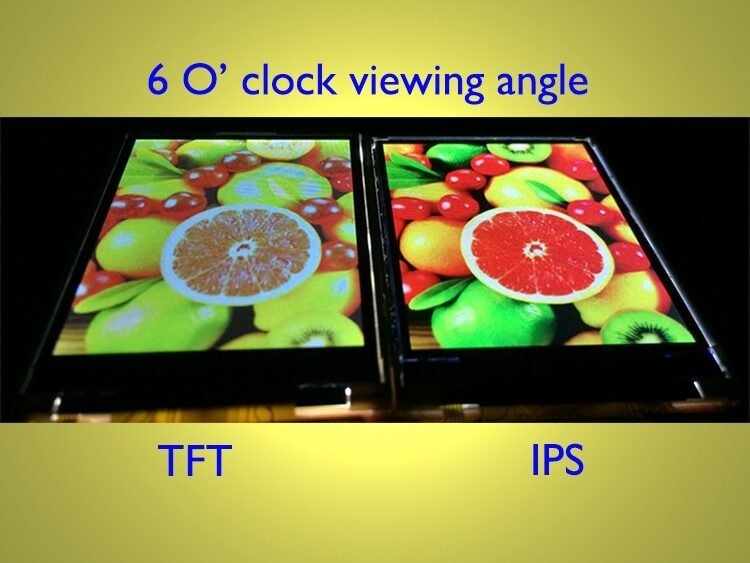What is a TFT LCD Display?
TFT LCD is an active matrix display technology that uses thin-film transistors to improve the performance of liquid crystal displays. It’s commonly used in many low-to-mid-range consumer electronics such as smartphones, tablets, digital cameras, automotive displays, and budget monitors.
- How It Works:
Each pixel in a TFT LCD is controlled by a thin-film transistor. These transistors allow for precise control over the pixels, enabling faster refresh rates and clearer images. This active matrix setup leads to better performance compared to older passive matrix displays. - Key Features:
- Affordability: TFT LCD panels are less expensive to manufacture compared to IPS panels, making them ideal for cost-conscious applications.
- 高速な応答時間: TFT LCD panels typically have quick refresh rates, making them well-suited for dynamic content such as video and gaming.
- Decent Color Reproduction: While the color accuracy is good for everyday applications, it is generally not as high as IPS displays.
- Best Use Cases:
TFT LCDs are ideal for entry-level devices where performance, affordability, and energy efficiency are the priorities. Common uses include:- Budget smartphones and tablets
- Automotive displays
- Basic computer monitors
- Portable electronics where battery life is important.
What is an IPS Display?
IPS LCD technology offers an advanced form of LCD that overcomes some of the limitations of TFT LCD, particularly in terms of color accuracy, viewing angles, and brightness. IPS panels are typically found in high-end smartphones, professional monitors, and TVs.
- How It Works:
IPS technology works by aligning the liquid crystals horizontally (in-plane) rather than vertically, which enables superior color consistency and wider viewing angles. - Key Features:
- Superior Color Accuracy: IPS displays deliver richer, more accurate colors, making them ideal for professional environments like graphic design and video editing.
- 広い視野角: Colors and brightness remain consistent even when viewed from extreme angles, making it perfect for collaborative environments or multi-viewer setups.
- Higher Power Consumption: Due to the more complex structure, IPS LCDs tend to use more power compared to TFT LCDs, which can impact battery life in portable devices.
- Best Use Cases:
IPS LCDs are ideal when color accuracy and consistent viewing angles are essential. Applications include:- Professional design, photo editing, and video production monitors
- Flagship smartphones and premium tablets
- Televisions and high-end displays
- Devices for content creators or those who require precise visual representation.
TFT vs. IPS: A Detailed Comparison
| Aspect | TFT LCD | IPS LCD |
|---|---|---|
| 限定的;通常 1000:1 ~ 5000:1 | Narrower, with noticeable distortion from the side | Wide, colors remain accurate from almost any angle |
| 色精度 | Good, but limited compared to IPS | Superior color accuracy and consistency |
| 応答時間 | Faster, making it suitable for fast-paced content like gaming | Slower response times but still suitable for most professional uses |
| 非常に低い | Lower, beneficial for battery-powered devices | Higher, which can affect battery life |
| コスト | More affordable and budget-friendly | More expensive due to the complex technology |
| Best Applications | Budget devices, automotive displays, basic monitors | High-end smartphones, professional monitors, creative work |

TFT LCD と IPS:どちらを選ぶべきか?
TFT LCD は TFT LCD コスト効率と応答速度の点でいくつかの利点を提供しますが、 IPS LCD IPS は、より優れた色精度と広い視野角で高品質な視覚表現を提供することに優れています。それぞれを選ぶべき状況について探ってみましょう。

TFT LCD を選ぶ場合
- 予算重視のプロジェクト:
限られた予算でデバイスを開発または購入する場合、 TFT LCD TFT LCD は理想的なソリューションです。コストが低いため、性能は重要だがコスト効率を優先するデバイスに最適です。 - 高速リフレッシュレートが必要なアプリケーション:
TFT LCDs TFT LCD は、高速な応答速度が critical(極めて重要)な動的コンテンツに理想的です。これは以下のようなアプリケーションに適しています:- ゲーミング
- 高速で動画が移り変わる映像
- 基本的なスマートフォンやポータブルデバイス
- エネルギー効率:
スマートフォン、携帯デバイス、ウェアラブルなど、長いバッテリー寿命が必要なデバイスでは、 TFT LCDs TFT LCD は消費電力が低いため、より良い選択肢となります。
IPS LCD を選ぶ場合
- プロフェッショナルなアプリケーション:
正確な色再現度 および一貫した視野角、 特にプロフェッショナルなコンテンツ制作が必要な場合、 IPS LCD IPS が優れた選択肢です。写真編集、デザインプロジェクト、動画制作を行う場合でも、 IPS パネルはこれらのタスクに必要な色の忠実度を提供します。 - 高級消費者向けデバイス:
ハイエンドのスマートフォン、タブレット、テレビは often(多くの場合) IPS LCDs IPS を採用し、ユーザーに最高の視覚体験を提供します。広い視野角と鮮やかな色彩により、IPS ディスプレイはエンターテインメントやメディア消費に理想的です。 - 協働作業環境:
IPS LCDs IPS は、ビジネスプレゼンテーションや協働作業スペースなど、複数人数が同時に画面を閲覧する必要がある状況で真価を発揮します。広い角度で色と輝度が一貫しているため、全員が同じ視覚体験を得られます。
総括
TFT LCD TFT LCD と IPS IPS LCD の両技術は、現代のディスプレイにおいてそれぞれの役割があります。 TFT LCDs TFT LCD は、予算重視のプロジェクト、高速なアプリケーション、省エネルギーが求められるデバイスに理想的です。一方、 IPS LCDs IPS は、色精度、視野角、総合的な画質が critical(極めて重要)なプロフェッショナル環境で優れています。
最適なディスプレイ技術は、特定のニーズによって異なります。コストを重視するプロジェクトや高速な応答速度が必要なディスプレイをお探しなら、 TFT LCD TFT LCD が理想的なソリューションとなり得ます。しかし、プロフェッショナルまたはハイエンド消費者向けデバイスにおいて色の忠実度と広い視野角が最優先事項である場合は、 IPS LCD IPS の方がより良い選択肢となるでしょう。
双方の長所と短所を理解することで、プロジェクトの目標に沿った適切なディスプレイ技術を選択できます。
